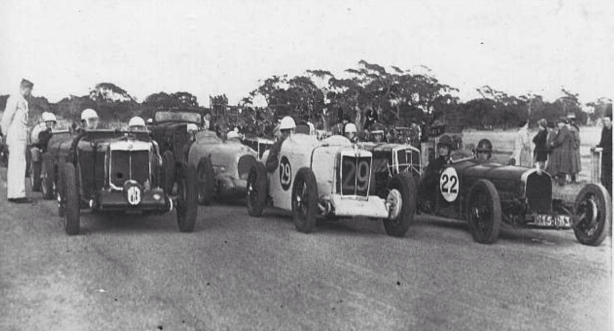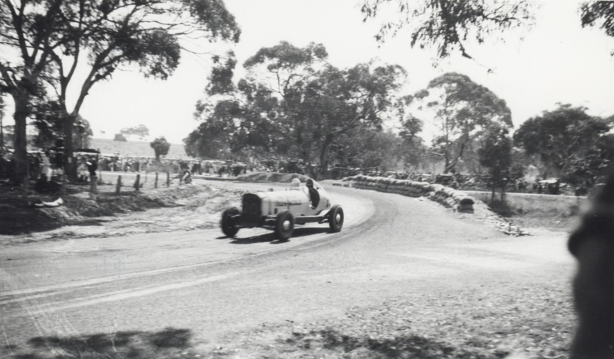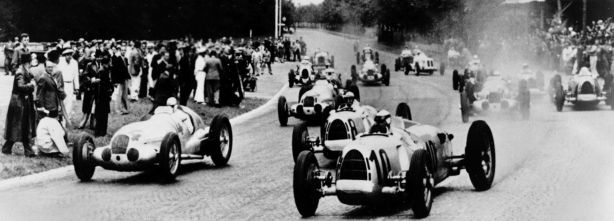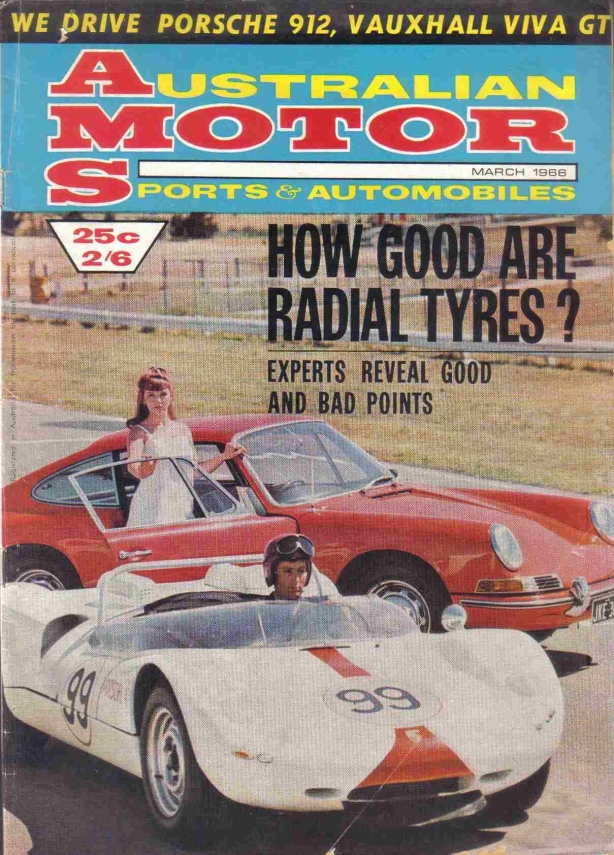
Alan Hamilton aboard the first of many ‘serious’ Porsches’ he raced in Australia down the decades, the ex-works 904/8 ‘Kanguruh’ chassis # 906-007 at Calder in January 1966…
Norman Hamilton famously negotiated a franchise for Porsche in Australia having been ’rounded up’ by one of the earliest 356’s on a drive through the Swiss Alps. The business quickly prospered from its Melbourne base, this article is about the ‘906’s raced by Norman’s son Alan from the mid sixties to early seventies and his career during that period.
He raced three such cars; 904/8 chassis # ‘906-007′ and two 906 Spyders; one during 1967 and another in 1971/2, the latter cars used chassis’ supplied by Porsche but neither had a chassis number, giving more than one historian a headache or two…
Alan Hamilton was born on 29 July 1942. After attending Camberwell High School in Melbourne’s leafy eastern suburbs he joined the family firm, which was to expand hugely over the ensuing decades under his leadership. A competition licence quickly succeeeded his road licence at 18, initial competition exploits were in a VW contesting trials and gymkhanas. A 1958 Porsche 356 Super followed, he competed at country meetings and hillclimbs, the car in standard form. A 1959 Convertible followed which was also successful.
In early 1965 Hamilton headed for Europe including a stint working in the Porsche factory, the 904/8 Bergspyder was purchased during that trip and shipped to Australia for the 1966 season, clearly a step up in performance for the young driver…

Majestic shot of a fabulous road racing circuit, ‘Long Bridge’ Longford Tasman Meeting 1967. Bob Jane leads Noel Hurd in Elfin 400 Repco and Elfin 400 Ford respectively. Hamiltons 2 litre Porsche 906 outgunned at this point by the 4.4 and 5 litre Elfins. (oldracephotos.com/Harrisson)
Porsche 906…
The 906 was produced for the 1966 World Championship of Makes. It was designed for the FIA’s Group 4 regulations, whilst modified variants of the car, using larger engines and/or cut-down Spyder bodywork, were entered in Group 6, the Sports Prototype category.
The 906 became the last street-legal ‘pure’ racer built by Porsche. It replaced the successful ladder frame chassis’ 904 and was the first substantial product of Technical Director Ferdinand Piech’s new team at Zuffenhausen. The Porsche 904 had additional structural rigidity from its bonded-on fiberglass bodywork, the new 906 featured a modern multi-tubular spaceframe chassis, with an unstressed fibreglass body.
The initial batch of 50 Porsche 906/Carrera 6 Coupes offered light weight, circa 1,300 lb (580 kg) a saving of around 250 lb (113 kg) compared to the similarly-engined 904/6.
The Porsche 901/20 6-cylinder lightweight racing engine was standard equipment, offering circa 220bhp on Weber carburetors.
A handful of factory-entered works cars were powered either by fuel-injected versions of the 6 cylinder engine, or the flat-8 derived from Porsche’s F1 program, both engines air cooled of course.
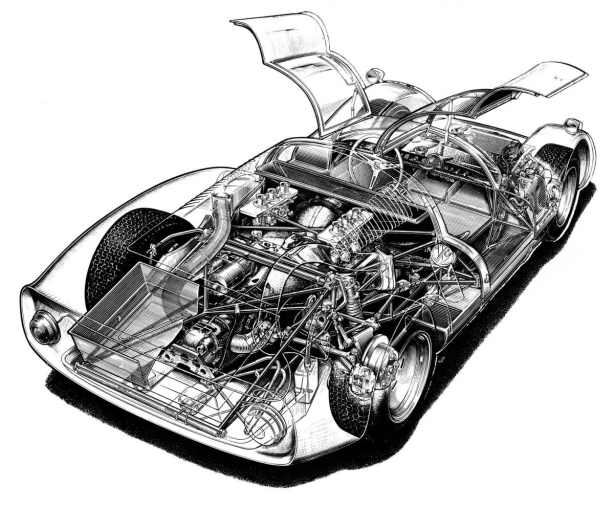
Porsche 906 Coupe Cutaway; multi-tubular space frame chassis, front suspension; wishbones and coil spring/dampers, rear; inverted lower wishbone, single top link, radius rods and coil spring/dampers. Adjustable bars front and rear. Rack and pinion steering. 6 cylinder SOHC 2 valve engine on carbs, 220bhp, 5 speed Porsche’box with synchros, steel wheels, disc brakes. (Inomoto)
The 906 shape was developed in the wind tunnel, a top speed of 170mph the result at Le Mans, amazing for a 2 litre car.
The cars made their international race debut in the 1966 Daytona 24 Hours, 6th overall and beating the Ferrari Dino 206 in the 2 litre class, the car driven by Hans Herrmann/Herbert Linge. At Sebring, Herrmann won the class again in a Carrera 6, this time co-driving with Gerhard Mitter and Joe Buzzetta, and finished 4th overall.
The Monza 1,000kms was dominated by 906s in the 2-litre class, this time with Herrmann/Mitter in a works entry leading home the customer car of Charles Vogele/Jo Siffert, these two cars placing 4th and 5th overall behind the victorious Ferrari 330P3 and a pair of Ford GT40s.
At the Targa Florio the 906 won outright, Willy Mairesse/Herbert Muller co-drove the Swiss Ecurie Filipinetti car.
The 1966 Le Mans works, prototype Porsche 906LE Coupes finished in 4th-7th places behind the leading trio of 7-litre factory Ford GT Mark IIs, outlasting all of the V12 engined sports-prototype Ferrari P3/4s, while the 2-litre Sports class was again dominated by a standard 906.
The Austrian 500kms event at Zeltweg saw Gerhard Mitter/Hans Herrmann and Jo Siffert (driving solo) finishing 1-2.
In 1967 the 906 continued to be campaigned by prominent private entrants and drivers, while the factory team moved on to race larger-engined 907’s on the relentless climb to development of the outright contender which finally won Le Mans for Porsche in 1970, the immortal 917.

The Colin Davis/ Porsche 904/8 ‘906-007’ on the way to 2nd place during Targa 1965. The radical cutaway of the body at the front to reduce overhangs on narrow hillclimbs clear in this shot. (Martha)

Jo Bonnier inserts himself into 904/8 ‘906-007’ during practice, both he and Graham Hill tried the car but elected to race a 904/8 Coupe #174, you can just see the nose of the car, with Hill at the wheel beside the Carabinieri. Car # 94 behind Bonnier is the #94 Pucci/Klass 904GTS. Porsche bought 7 cars to the event, all but 2 ‘T Cars’ started. (Martha)
The Porsche 904/8…
The 904 based ‘Bergspyders’ played an important test role in the evolution of the 904 to 906, the first appearance of these cars was at the Targa Florio on May 9 1965.
All 904’s came from the factory with 2 litre engines; 4, 8 and 6 cylinders. Generally the ‘4 potters’ had ‘904’ chassis numbers, 6 cylinder cars ‘906’ chassis numbers. It was no rule though, the first prototype chassis ‘904-001’ had a 6 cylinder engine, the 8 cylinder coupes had ‘904’ chassis numbers whilst the 8 cylinder Spyders had ‘906’ chassis numbers. Easy really!
Porsche built 5 ‘904/8’ cars for factory use; chassis ‘906-003’, ‘004’, ‘007’, ‘008’ and ‘009’. To be clear, whilst the chassis had ‘906’ descriptor numbers the cars used 904 ladder frames, not the 906 spaceframe chassis.
All 904/8’s had 2 litre flat 8 engines; the Type 771 1962cc engine was derived from the 1962 804 F1 car and produced about 225bhp, fed by Weber carbs.
The cars were made in two body variants. Chassis ‘003’, ‘004’ and ‘009’ had the ‘normal’ Spyder look of a Porsche of the period, the other two cars ‘007’ and ‘008’ were more ‘visually challenging’, that is ugly! The overhangs were shortened a lot for hillclimbing purposes.
‘Bergspyder’ as a name was a misnomer as the cars were raced as well as ‘climbed, they were nicknamed ‘Kanguruh’ (kangaroo) because of the nature of the cars roadholding, the lightweight cars with their firm suspension jumped about on poor roads.

A couple of fabulous stationary shots of 904/8 ‘906-007’ at Targa 1965. #72 is the Alfa TZ1 of Panepinto/Parla DNF. (Martha)
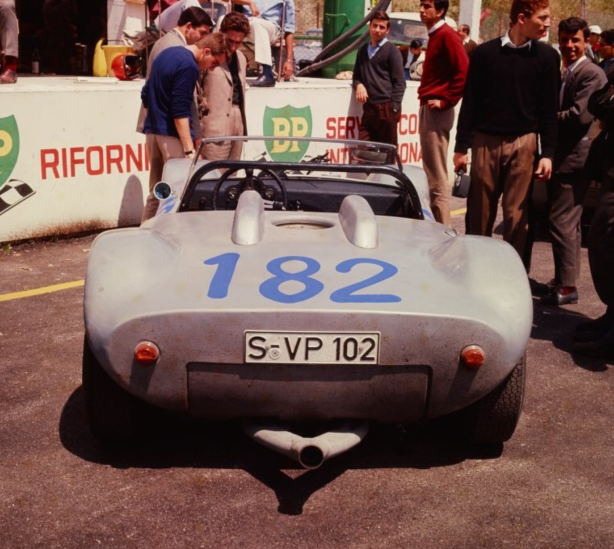
And back…by far the better angle! (Martha)
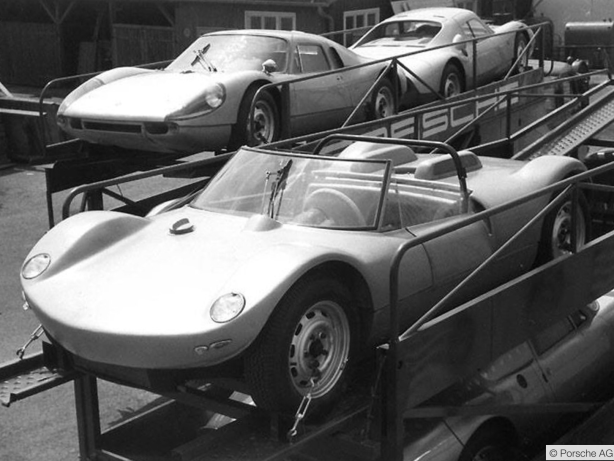
The Porsche team arrive at Targa, May 1965. Cars are 904GTS Coupes and the Spyder, 904/8 ‘906-007’chassis driven by Davis/Mitter. (PorscheAG)
Hamiltons 904/8 car chassis ‘906-007’ was first raced at Targa 1965,
It finished second in the hands of Cliff Davis/Gerhard Mitter behind the winning Ferrari P2 of local lad Nino Vaccarella and Lorenzo Bandini.
Gerhard Mitter then used the car to win the 1965 Rossfeld Hillclimb, a 6Km course near Berchtesgaden on 13 June, next placed Herbie Muller was 5 seconds adrift in a standard Porsche 904GTS.

Carabinieri taking an interest in the 2nd placed 904/8. # 94 is the works 904GTS of Pucci/Klass 5th, #106 is the Lancia Flaminia of Raimondo/Lo Jacono, which finished but was unclassified. Privateers the lifeblood of Targa! (Martha)
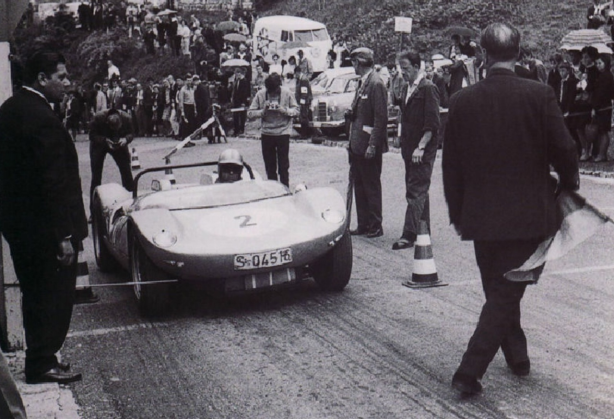
Mitter on the startline of Rossfeld, Germany 1965. Win for 904/8 ‘906-007’. (unattributed)
Further success followed at the Norisring, near Nurnberg, Mitter raced ‘906-007’ to victory on July 4 1965 leading home two Elva BMW’s. The car was then unraced, the last appearance of a 904/8 was in August, in factory hands, Porsche thereafter focussing on production of the new 906.
Alan Hamilton spotted the car in a corner of the racing department…

Car #2 Mitter at the Norisring, victorious in the 904/8 again. Car #3 is a Lotus 23 driven by Anton Fischhaber, #5 Chris Williams’ Lotus BMW. (unattributed)
Porsche 904/8 ‘906-007’ in Australia…
Interviewed by Journalist Barry Lake, Hamilton said the 904/8 ‘originally had a 2 litre 8-cylinder engine, but I bought it with a new 906 (6 cylinder) engine I had asked them to install. I imported that at the end of 1965 and raced it through 1966.’
The car was first raced in Australia at Calder, Victoria on 16 January 1966, which is probably when the Autosportsman cover shot used at the start of this article was taken. The car then raced at the Sandown round of the Tasman Series, contesting the sports car events.
Taken across Bass Strait on ‘the Princess of Tasmania’ with the rest of the ‘Tasman Circus’ to contest the Australian Tourist Trophy at Longford, Hamilton was second in the race won by the much more powerful Elfin 400 Traco Olds V8 of Frank Matich.

Alan Hamilton in his Porsche 904 ‘906-007’ in one of its earliest appearances in Australia, at the 1966 Australian Tourist Trophy, Longford in March 1966. Alongside is Spencer Martin’s Ferrari 250LM and on the far side Frank Matich, in the victorious Elfin 400/Traco Olds. Hamilton was second, Martin third. (Ellis French)

Alan Hamilton navigating Surfers Paradise traffic during the 1966 12 Hour. Porsche 904 ‘906-007’. Car #5 the ex-Moss/Stillwell Cooper Monaco Olds of Osborne/Carter/Gibbs. (David Blanch)
The 904 quickly became one of the fastest sportscars in the country, fourth in the 1966 Surfers Paradise 12 Hour with a 2 litre car was a top result. Alan shared the 904 with Melbourne driver Brian ‘Brique’ Reed. Jackie Stewart and Andy Buchanan won in the Scuderia Veloce Ferrari 250LM- i wrote an article about this Ferrari a while back, click here to read it; https://primotipo.com/2014/07/03/pete-geoghegan-ferrari-250lm-6321-bathurst-easter-68/
The Hamilton 904 combination were also first in the 1966 Australian Hillclimb Championship at Collingrove, South Australia, the Victorian Sports Car Championship at Sandown and the South Australian Sports Car Championship at the Mallala ex-airfield circuit.
Towards the end of 1966 the Porsche workshop in St Kilda, Melbourne started to transfer the mechanicals of the ‘Kanguruh’ 904/8 ‘906-007’ to a new 906 chassis.
Alan Hamilton ‘Later (that is after the 904/8 was in Australia) I imported a new 906 chassis and body and put the mechanicals of the Targa car in that’.
‘Then Jim Abbot bought the Targa car (chassis 904/8 906-007) and fitted a ZF gearbox and 289 Ford V8 engine. His estate or perhaps Jim himself shortly before he died, sold the car to Murray Bingham in this form and it became the Bingham Cobra.’

Longford March 1966, second in the Australian Tourist Trophy. 904 ‘906-007’. (oldracephotos.com/King)

Alan Hamilton ‘fairly hooting through here, scary to watch’ in the view of the photographer. Templestowe Hillclimb, outer Melbourne 1966. 904 ‘906-007’. (onelung)

Another shot of Hamilton in the 904 at Templestowe Hillclimb, 11 September 1966, he broke the climb record on the day. (Stephen Dalton Collection)
Hamilton; ‘Years later, Pat Burke bought the car and sent it to Germany where it was restored to its original 904/8 Targa Florio specification. After Pat Burke fell on hard times it was auctioned at Monte Carlo. I think a man in Sydney bought it, but I have no idea who has it now.’
Lets go back a step to the acquisition of the chassis and related parts by Jim Abbott.
Abbott was a driver, owner of Lakeland Hillclimb in outer Melbourne, publisher of motor racing monthly ‘Autosportsman’ magazine and promoter of an annual Motor Racing Show in Melbourne.
In 1966, 1980 World Champion, Alan Jones was trying to establish a foothold on the motor racing ladder in the UK, wheeling and dealing in cars and campers to provide the money to do so. He acquired an ex-works Sunbeam Tiger and knowing Abbott had an interest in such cars sold it to him. The car was raced and ‘climbed’ by Jim and engineer Paul England before Abbott decided it would make a nicer road car than a racer. He swapped the Shelby modded 289cid V8 for a standard engine and looked around for a chassis into which to plonk his nice, powerful Ford Windsor ‘small block’ V8.
Various Coopers were considered before a deal was done with Hamilton to acquire the Kanguruh 904/8 ‘906-007’.
A suitable ex-Cooper Maserati F1 ZF 5DS 25 transaxle was also acquired. The engine and box (the latter requiring some modification in terms of clutch componentry by Eddie Thomas) was ‘dropped’ into the Porsche chassis at Hamilton’s St Kilda workshop.
A little ‘cutting and shutting’ of the chassis cross-member was needed to fit the V8, a sub-frame was added around the engine to maintain chassis stiffness, but in essence the swap was relatively simple. Stiffer springs and shocks were fitted as the Ford cast iron lump was around 200lbs heavier than the svelte, alloy Porsche Flat 6. Driveshafts were suitably strengthened by Paul England Engineering.
The original rear bodywork was used but at the front, much bashed and repaired a local specialist fashioned a nose much more attractive than the original, the screen, a concoction of a speedboat parts, met at each end with aluminium panels was not quite so pretty.
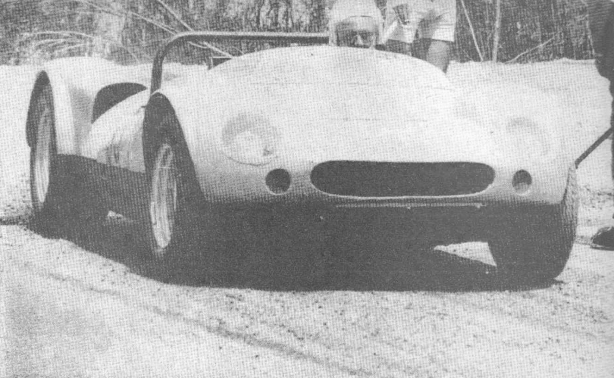
Jim Abbott in 904 ‘906-007’ now called a ‘Porsche Cobra’ in deference to the 289cid Ford engine installed. This shot is probably at Lakeland in outer Melbourne, a venue owned by Abbott. Front of the much bashed and repaired body re-worked. (Autosportsman)

Fairly scratchy shot shows the ZF 5DS 25 beefy gearbox if not the engine. Chassis other than minor mods to fit the engine, as built by Porsche. Front and rear suspension sold with the car by Hamilton to Abbott also standard. (Autosportsman)
Abbott’s objective was not to build an outright car but rather a very fast sports car which could be ‘raced, sprinted and climbed’. The completed car made is debut at the Light Car Club of Australia’s annual members meeting at Sandown on Melbourne Cup Day in November 1967, ‘Red Handed’ won the ‘Cup at Flemington that day!, more importantly Abbott set a sub-13 second standing quarter mile at Sandown, also, primarily a horse racing venue.
The car was quickly under the times set by the class record holder, a Cooper Jaguar at Templestowe Hillclimb and was running 4th in the ‘Winton Trophy’ at the picturesque Benalla country Victorian circuit when the car lost its water. Initial troubles centred around the cooling system, which were solved by fully rebuilding it.

Jim Abbott, ‘Porsche Cobra’ 904/8 ‘906-007’, Lakeland Hillclimb 1967. These are scratchy shots but included for the sake of completeness. Abbott looks huge in the cars cockpit. Screen is from a boat. (Autosportsman)
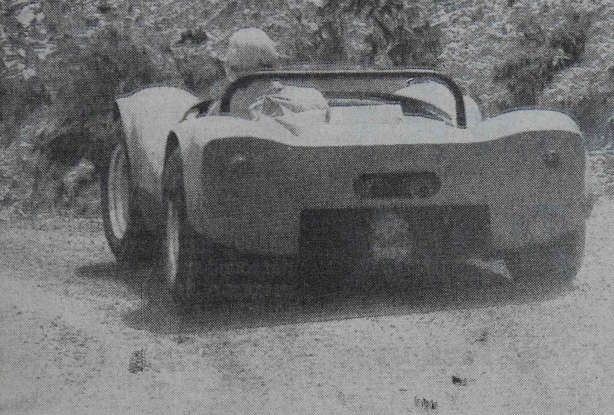
Jim Abbott, Porsche Cobra 904/8 ‘906-007’, Lakeland Hillclimb 1967, 2 years before victorious at the much more grand, Rossfeld, Germany hillclimb. (Autosportsman)

Tom Sulman in the Porsche Cobra at Huntley Hillclimb, NSW on 1 June 1969 (T Arts)
Abbott did not campaign the car for long before his untimely death, it was then sold to New South Wales veteran driver, Tom Sulman who raced it in 1969.
Murray Bingham then bought 904/8 ‘906-007’ and used it very successfully for over 10 years, the old chassis won the Australian Hillclimb Championship again in 1972, a three round Series that year. (Hamilton won the ’66 title in it at Collingrove).
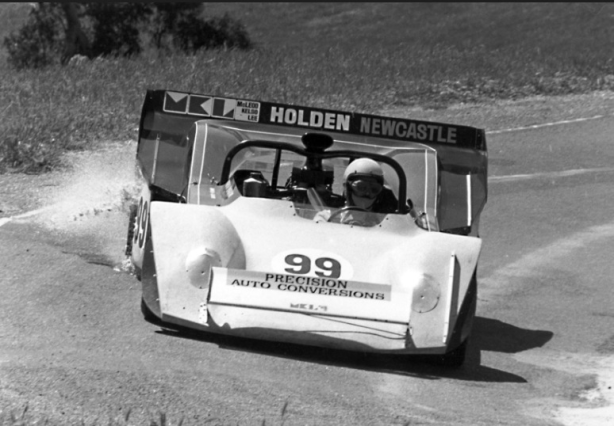
Murray Bingham in 904/8 ‘906-007’ then known as the ‘Bingham Chev’ in, probably, 1972 at Collingrove, Angaston, SA. Check out the downforce being sought front and rear. (John Lemm)
A ‘Manx’ body replaced the original and the Ford Cobra engine was updated with an ex-Garry Campbell, Alan Smith built Chev F5000 engine out of a Lola T300, Bingham won the 1973 NSW Hillclimb Championship in Chev engined form, the 1971/2 NSW Titles Ford Cobra engined.
The much raced car finally passed into the hands of Pat Burke who restored it before it was sold upon the demise of his business empire in the 1980’s as described by Alan Hamilton earlier in the article.
I am uncertain of the cars current owner.

Murray Bingham in 904/8 ‘906-007’ in its hillclimbing years, King Edward Park, Newcastle, NSW. Car known as ‘Bingham Cobra’ and ‘Bingham Chev’ when fitted with Ford 289 and Chev F5000 engines respectively. ‘Manx’ body (unattributed)
Hamilton’s first Porsche 906 Spyder…

Australian Autosportsman June 1967 cover depicts the Alan Hamilton Porsche 906 Spyder at Longford in 1967. (Stephen Dalton Collection)
Hamilton’s new 906 chassis came with bodywork, suspension and brakes.
904/8 ‘906-007’ donated its engine and gearbox and some other components, as the narrative and photos show, the 904/8 ‘906-007’car was still as built by Porsche less the engine and ‘box. Alan is a big, tall bloke so elected to build the 906 up as a Spyder rather than a standard 906 Coupe in order to ease access and egress and more easily see out of the car.
At this point we have two cars;
The 904/8 chassis car # ‘906-007’, now called ‘Porsche Cobra’ and fitted with a Ford engine and ZF gearbox.
A 906 which was not issued a chassis number by Porsche but which over the years assumed the # ‘906-007’ tag, which was built up as a Spyder but which when restored in Germany in 2003-2009, was rebuilt as a Coupe. This chassis now has a chassis ‘906-007’ plate, at what point the plate was affixed is conjecture.
Both cars have elements of the original 904/8 ‘906-007’…

Another majestic Longford shot. Hamilton Porsche 906 Spyder 1967. (oldracephotos.com/King)
Back in 1966 none of these problems for future historians mattered to Hamilton, he had a new ‘state of the art’ 906 to contest Australian events.
As the recent article i wrote on the Frank Matich Elfin 400/Traco Olds makes clear, the light 6 cylinder engined Porsche was ‘up against it’ with several very potent, light, well driven V8 powered cars in the hands of Frank Matich, Niel Allen and Bob Jane in 1967. (Matich SR3 Repco, Elfin 400 Chev and Elfin 400 Repco respectively).
The Porsche Team competed the build of the 906, the original 904 chassis ‘906-007’ was put out the back of their St Kilda workshop until acquired by Jim Abbott later in 1967.
The 906 Spyder made its debut in the sports car events at Sandown’s Tasman round in late February 1967. Hamilton took 3 class wins and a class lap record.
To Longford the following weekend the car was third outright. The following week, still in Tasmania, Hamilton raced the car at Symmons Plains, he won his first race and was leading the ‘Tasmanian Sports Car Championship’ event when a conrod let go. Hamilton noted in his ‘Autosportsman’ column that the engine had ‘done 14 months racing, 92 hours so we are more than happy with its overall performance’, Porsche reliability legendary.
In April Hamilton contested the ‘Victorian Sportscar Championship’ winning his heat and finishing second outright and first in class, he also bagged the class lap record.

The Hamilton 906 in the Warwick farm paddock, May 1967. Note the ‘chin wing’ and pretty front of the car. (WOT)

Sensational Bruce Wells shot of Hamilton contesting the ‘RAC Trophy’ at Warwick Farm in May 1967, here in ‘The Esses’. Sans the wings in the paddock shot. Porsche 906 Spyder. (Bruce Wells/The Roaring Season)
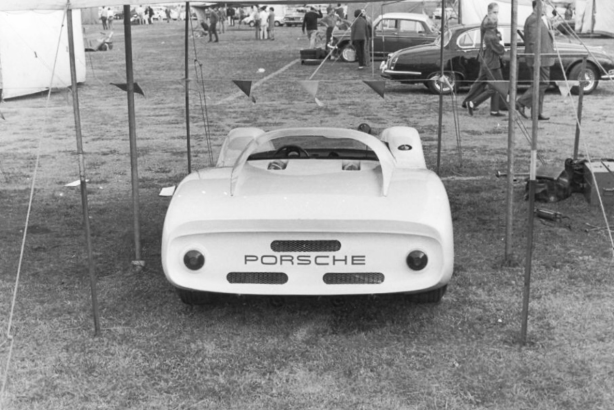
Warwick Farm 906 ‘butt shot’, May 1967. (WOT)
On 14 May Hamilton contested the ‘RAC Trophy’ at Warwick Farm, he finished third behind two powerful V8’s. The dominant Matich SR3 of Frank Matich was getting in some valuable mileage before leaving to contest the Can Am Series in this car, and Bob Jane’s Elfin 400 which, like the SR3, was powered by Repco’s new ‘620 Series’ SOHC, 2 valve, 4.4 litre V8.
A week after the ‘RAC Trophy’ Hamilton contested the ‘Australian Tourist Trophy’ at Surfers Paradise. This was a relatively easy tow from Sydney to Queensland’s Gold Coast and gave Hamilton valuable testing time at Surfers to fettle the car to suit the circuit for the international 12 Hour event in September.
Matich won again in his SR3 Repco, but Alan was second in the 906 and his 12 Hour co-driver Glynn Scott third in his Lotus 23B Ford. The other two outright sportscar contenders of that year, Niel Allen and Bob Jane’s Elfin 400’s did not make the trip North.
Success followed in Victorian events at Calder and at Hume Weir on the Queens Birthday weekend, before taking the long haul back to Surfers Paradise for the 12 Hour event on the 3 September weekend .

Alan Hamilton awaits the rest of the grid at Hume Weir in 1967. Great little circuit built in a quarry created when land fill was excavated to create the Hume Weir Dam. Porsche 906 Spyder. Top shot shows the lines of this car superbly. (unattributed)

Hume Weir, Queens Birthday weekend 1967. AH on pole in his 906, #6 is ‘Gold Star’ reigning national champion, Spencer Martin having his first drive of Bob Jane’s Elfin 400 Repco and the nose of Bevan Gibson’s Lotus 15 Climax FPF. (The Nostalgia Forum)
Hamilton’s co-driver at Surfers was Queenslands’ Glynn Scott, the duo finished third outright and first in class. The race was won again by the SV Ferrari 250LM, that year driven by the Australian duo of Bill Brown and Greg Cusack, Paul Hawkins and Jackie Epstein were second in Epstein’s Lola T70 Mk3 Chev.
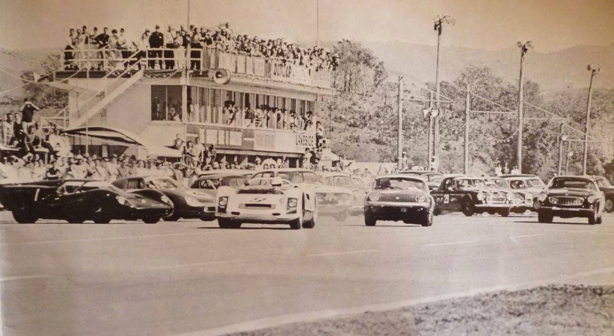
Alan Hamilton very fast ‘out of the blocks’ at the start of the ’67 Surfers 12 Hour in the #9 906. #1 is the 2nd placed Lola T70 Mk3 Chev, with Paul Hawkins at the wheel, the winning Ferrari 250LM is alongside Hawkins. The Lotus Elan is probably the McArthur brothers car, the Datsun 1600 #29 the ‘works’ 1600 of Tapsall/Woelders DNF and the Volvo P1800S driven by Keran/Bond/Winkless 10th. (unattributed)

Hamilton corners the 906 at ‘Lukeys’ during the Surfers 12 Hour. (Peter Baldwin)
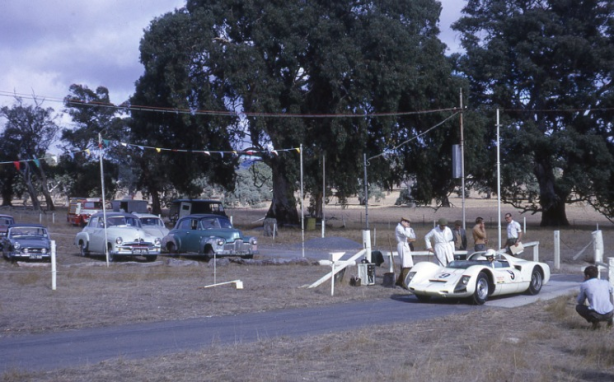
Hamilton on the Collingrove Hillclimb startline in April 1967. He set a track record of 35.60 seconds in the 906 at this meeting. (John Lemm)
Another long tow to Mallala, South Australia was rewarded with victory in the ‘South Australian TT’.
John Blanden noted the versatility of the car and driver, the 906 contested hillclimbs, still pretty important and sometimes televised, the car taking FTD at Templestowe in Melbourne’s outer east and second in the Australian Hillclimb Championship at Bathurst in November behind Greg Cusack’s Tasman 2.5 litre Repco powered Brabham BT23.
A successful year was capped with a win at Lakeland Hillclimb in the Dandenong Ranges, outer Melbourne in December.

Alan had a win at Lakeland Hillclimb close to home in December 1967 (G Fry)
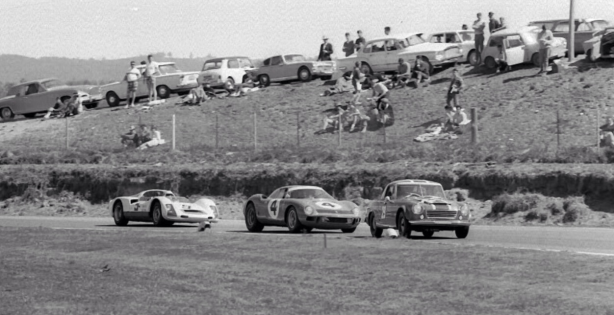
The Roxburgh/Whiteford Datsun 1600 ahead of the Cusack/Brown Ferrari 250LM and Hamilton/Scott Porsche 906 Spyder. Surfers 12 Hour 1967.(Ray Bell)
The 906 was advertised for sale in the November 1967 issue of ‘Racing Car News’, the car according to John Blanden having reached its Customs Duty limits. This taxation concession allowed Tasman Series competitors, for example, to avoid import duty by ‘exporting’ the cars each year to New Zealand. If exceeded, that is the car stayed in Australia for longer than twelve months, the ‘fiscal fiend’, the taxman, had to be paid.
The car was sold to Richard Wong in Singapore and passed through many hands including Macao businessman/racer/team owner Teddy Yip. As mentioned earlier in this article Hamilton’s first 906 was ultimately restored as a Coupe having been only raced by Hamilton as a Spyder…

Alan Hamilton, Porsche 906, Symmons Plains 1967 (HRCCT)
European Trip in 1968…
Hamilton spent most of 1968 overseas much of it working at Porsche, he did manage to fit in the Nurburgring 1000Km, racing a 911S to 28th place with co driver/car owner Hans-Dieter Blatzheim. The race was won by a factory Porsche 908 driven by Jo Siffert and Vic Elford.
Planning an all out assault on the 1969 Australian Touring Car Championship, Hamilton ordered a trick 911T/R, the car arrived early enough to compete in the 1968 ATCC, the last run to a one race format. Pete Geoghegan won the title again in his Mustang, Hamilton in the giant killing 2 litre 911 lost 2nd place on the last lap due to a puncture, Darrell King’s Morris Cooper S just beat him to the Warwick Farm chequered flag.
Porsche still had some spare 906 chassis’ lying around the factory, one was offered to Alan who was happy to oblige, he still had plenty of bits from the earlier cars so could easily build up another car for competition back in Oz.
This 906, like the previous chassis he raced in ’67 did not have a chassis number.

Hamilton has his 911T/R in a beautifully balanced 4-wheel drift during his run to 3rd place in the one race Australian Touring Car Championship at Warwick Farm in September 1968. A flat tyre cost him 2nd on the last lap. Pete Geoghegan won the title in his Ford Mustang. This car left Oz many years ago.(autopics.com.au)

Alan Hamilton exiting Clubhouse Corner at Mallala on 16 June 1969 during the ‘South Australian Touring Car Championship’, round 3 of the ATCC in 1969. AH was 2nd behind Pete Geoghegan, the first of 4 2nd places he achieved that year, the 2 litre 911T/R did not quite have the ‘Mumbo’ to knock off the big Mustang. (Dick Simpson)
In the 1969 ATCC he came very close to taking the title with consistent second places, ultimately the championship was won by Pete Geoghegan by 1 point, in his Mustang, the fifth win in the event for the beefy, supremely talented Sydneysider.
The battle went down to the wire in the final round at Symmons Plains.
In the middle of his ATCC campaign Hamilton was recruited by ‘Big Al’ Turner to drive a factory Ford Falcon XW GTHO Phase1 in the Bathurst 500 together with 500 debutant Allan Moffat that October.
Moffat was in good form having won the preceding Sandown 500 in his big Falcon. Still a young driver, Turner was keen to exploit Hamilton’s speed, smoothness and mechanical sympathy. It was the start of a relationship between the drivers which would be mutually beneficial over the next decade.
1969 was the famous Bathurst when tyres imported by Turner failed spectacularly, Moffat was called into the pits for a precautionary check after the tyres on the Brothers Geoghegan and Gibson/Seton cars failed. The Moffat/Hamilton duo were easier on the Goodyears than their teammates, the pitstop unnecessary and probably the cause of the pre-race favourite Falcons losing victory. The Holden Dealer Team Holden Monaro HG GTS350 of Colin Bond and Tony Roberts won the race.

Moffat/Hamilton Ford Falcon GTHO, Bathurst 1969. (autopics)
In 1970 Alan didn’t contest the ATCC but the second Hamilton 906 was assembled. The car had a standard 906 ‘front clip’ but, like the earlier 904/8 ‘906-007’ and 906 was a Spyder, the rear deck modified locally with pronounced ‘spoilers’ to provide some downforce. No wing though.
Minilite wheels replaced the factory steels of the earlier cars, the car was ready for the 1971 Australian Sportscar Championship powered by a 2.4 litre twin plug engine assembled locally from Alan’s cache of trick, Porsche bits.
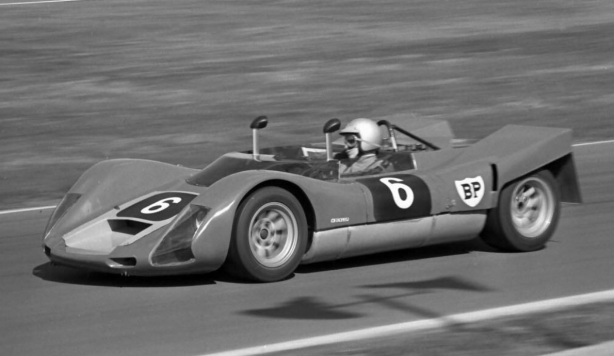
Hamilton in his second 906 at Warwick Farm on 2 May 1971. The standard 906 front, Minilite wheels and modified rear deck are all clear. Like his earlier 906 this chassis was not allocated a number by the factory. (lyntonh)
Hamilton’s second 906 Spyder…
1971 was to be a big year of racing for Hamilton. In amongst the rapid growth of Porsche Cars Australia, a strong economy and global growth in the Porsche brand reflected in strong sales in Australia, Hamilton took the big step up to Australia’s premier single-seater class, F5000.
He purchased Niel Allen’s spare McLaren M10B Chev (#400-19) upon Allen’s retirement from the sport. (Ignoring Allen’s short flirtation with a Lola T300 12 months later). Kevin Bartlett bought Niel’s other M10B (#400-02), all these years later Hamilton owns both McLarens, they are being historic raced by Alf Costanzo. In the seventies and eighties Alfie was Hamilton’s driver in a swag of F5000 and F Pacific cars in which the little Italian born Aussie was prodigiously fast. A tangent too far for this long article!

AH in his McLaren M10 B Chev, F5000, Oran Park June 1971. (lyntonh)
Hamilton missed the 1971 Tasman Rounds but both he and Bartlett had their cars ready for a full Gold Star campaign. Despite being a novice in these big, brutal, challenging cars Hamilton was immediately competitive taking third places at Oran Park, Surfers Paradise and Mallala.
He was fourth at Lakeside, finishing the Series equal second with Bartlett in his M10B. Winner of the series was the speedy and consistent Max Stewart in his Mildren Waggott 2 litre in a final Championship victory for this superb Australian 4 cylinder DOHC 4 valve engine. Stewart progressed to an Elfin MR5 Repco at the end of the Series and was consistently competitive in the big cars for the rest of his career.
The Porsche Cars Australia transporter did plenty of miles from its St Kilda base in 1971 in pursuit of two national championships and the vast distances across the big Australian continent that entails.

Alan Hamilton cornering his McLaren 911 style at Warwick Farm 1971, date unknown. Car is chassis ‘400-19’, Niel Allen’s spare built up by Peter Molloy and sold, together with his race chassis ‘400-02’ to Alan Hamilton and Keven Bartlett respectively. Full monocoque aluminium chassis, 500bhp fuel injected 5 litre Chev engine, Hewland DG300 gearbox…much more powerful than a Porsche 906! (unattributed)

In the best of company during the 1971 AGP at Warwick Farm. John Surtees from Hamilton, Colin Bond and Graeme Lawrence. Surtees TS8 Chev, McLaren M10B Chev, McLaren M10C Repco and Brabham BT30 Ford. (lyntonh)

Side on view of Hamilton’s 906 in 1971, here at the RAC Trophy meeting at Warwick Farm, ‘Northern Crossing’ in May 1971. (lyntonh)

Butt shot of the car, same day as above, the neat upswept tail providing downforce but also not too much drag given the little 2.4 litre flat-6 propelling it all…(lyntonh)
In 1971 Hamiltons 2.4 litre twin-plug Porsche 906 was as out-powered as the earlier cars were in 1966 and 1967.
The fastest combination in the field was John Harvey in Bob Jane’s McLaren M6 Repco, a 5 litre SOHC ‘740 Series’ V8 producing around 460bhp@7500rpm. Best results for the 906 were thirds at Phillip Island in January and Warwick Farm in May.
Whilst outgunned on the track, the nimble 906 was just the thing at Hillclimbs, Hamilton had a passion for these events and at Easter took fastest time of the day on 10 April, a track record and the Australian Title, his second win, the first in the 904/8 also at Collingrove in 1966. The Angaston Hills were alive to the sound of flat 6 music…
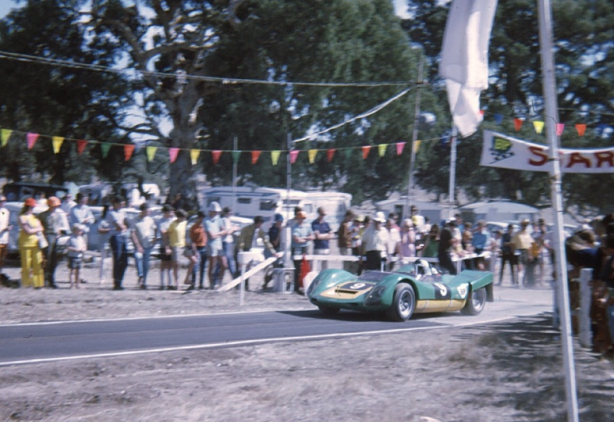
Alan Hamilton launches his Porsche 906 off the line at Collingrove, Angaston in South Australia’s Barossa Valley. Easter 1971. Hammo set a track record of 33 seconds dead at this meeting. (fredeuce)
At the end of the year Hamilton sold the McLaren to Pat Burke (later the restorer of the 904/8 ‘906-007’) for his driver Warwick Brown, the M10B an important stepping stone for the talented driver on his climb towards the top of the class in both Australasia and the US.
This M10B chassis was then used as the donor car for Bryan Thomson’s ‘Volksrolet’ VW Fastback Sports Sedan project, before being restored, around the original tub, which had never been destroyed, many years later, by Alan Hamilton as mentioned above.

A lap or so from disaster, Dandenong Road corner. AGP Sandown 1978. AH was running a comfortable 2nd in his Lola T430 Chev, behind race winner Graham McRae McRae GM3 Chev when he lost the car across The Causeway section of the old circuit, at high speed hitting Dunlop Bridge and hurting himself very badly. Fortunately he survived, the car was carved in half, destroyed. In the last 5 years it has been reconstructed by the ‘NZ F5000 Industry’ around the cars remains which comprised ‘half its vinyl Lola nose badge’…(G Howard ‘History of The AGP’)
Hamilton returned to F5000 in 1978, that campaign ended in near tragedy at Sandown when he crashed his ex-Team VDS Warwick Brown Lola T430 Chev at the high speed Dunlop Bridge, the car was destroyed, carved in half, Alan lucky to survive, he became a diabetic as a consequence and has been unable to hold a full licence since.
Not that it stopped him winning two Australian Hillclimb Championships in 1981 at Ararat and 1989 at Gippsland Park, both in Victoria in Porsche Spl and Lola T8750 Buick respectively. He was lucky to survive the Sandown accident and was a significant patron to other drivers, notably Costanzo post prang.
In 1972 Hamilton continued to campaign the 906, John Harvey won the title again in the Bob Jane McLaren M6 Repco with Hamilton second in the title, 20 points adrift of Harvey with seconds at Phillip Island, Adelaide International, Warwick Farm and Surfers Paradise.
The championship had a bit of a renaissance that year with some new cars appearing, notably the Elfin 360’s of Phil Moore and Henry Michell, also the Rennmax of Doug Macarthur all powered by ex-Tasman Series 2.5 litre V8 Repco engines now surplus to requirements with F5000 as the new ANF1.

Victory lap, Sports Sedan race at Oran Park May 1972. Alan Hamilton #9, Jim MkKeown in 911’s, Pat Peck in a Holden Torana GTR XU1 and Bill Brown #7 in another 911. (lyntonh)
Alan also raced a Porsche 911S sports sedan during this period but the 906 racing days were over. The car was rebuilt as Coupe in the 1980’s by the Porsche workshop in Melbourne. It appeared occasionally, notably at a couple of Adelaide Grand Prix historic demonstrations, the car finally sold by Hamilton in the 1990 via auction to a Japanese owner.
Hamilton raced on in a variety of cars and became a very generous team owner after his own front line racing days ceased post accident, he is still active in the historic scene and lives on a property at Red Hill on Melbourne, Victoria’s Mornington Peninsula.

Hamiltons second 906, originally raced as a Spyder in 1971/72 now restored and rebodied as a Coupe and pictured here at Sandown in 1985. Restoration done in the Melbourne/Dandenong Porsche Cars Australia workshops. (Historic Racing Cars in Australia)
Etcetera…

Australian Autosportsman April 1967
904/8 ‘906-007’.

Refuelling 904/8 of Davis/ Mitter, Targa 1965. (Bernard Cahier)

Type 771 flat-8, 2 valve, DOHC, Weber carbed engine a development of Porsche’s 61/2′ F1 program. Circa 225bhp. (unattributed)

904/8 rear suspension and engine. Upper and lower wishbones, coil spring/dampers, radius rods. Disc brake, fuel tank all clear to see. 904 chassis of ladder frame type. (unattributed)
Bibliography…
‘Historic racing Cars in Australia’ John Blanden, The Nostalgia Forum, Australian Autosportsman Magazine March 1966 and April 1967
Stephen Dalton for his research and access to his archive/collection
Photo Credits…
oldracephotos.com, ‘onelung’, Bernard Cahier, lyntonh, G Howard ‘History of The AGP’, autopics.com, Dick Simpson, Bruce Wells, The Roaring Season, freduece, Ray Bell, David Blanch, Ellis French, John Lemm, Peter Baldwin, Jean Charles Martha, Yoshihiro Inomoto, Gavin Fry, Tony Arts, Historic Racing Car Club of Tasmania
Finito...














